Easy ramyun recipes to try
Due to the current pandemic, many of us are either working or studying from home. Cooking at home may be cheaper than buying takeaway food outside, but it’s time-consuming. Ordering food online is an option too, but it’s expensive and unsustainable for many of us.
So the easiest and cheapest way to settle meals comes to mind – cook ramyun. But don’t settle for just plain ramyun, because that’s rather sad and there are ways to make the dish more nutritious. Here are 8 easy ramyun recipes that will level up the humble dish.
Table of Contents
1. Rabokki

Image credit: @fo_odvly
Just as its name suggests, rabokki is a ramyun dish with tteokbokki as its main ingredient.
Tteokbokki is a beloved Korean street snack, well-known for its spiciness and chewy texture.
There’s no better person to learn from than Paik Jong-won, one of Korea’s most popular celebrity chefs. The recipe below was created by him, and he claimed that it only takes one minute to make. This is a recipe perfect for busy days.
In Paik Jong-won’s video, he doesn’t use tteokbokki, but you can buy a pack of instant tteokbokki online or from a Korean mart and add it to your ramyun.
Ingredients:
- 1 pack of ramyun
- Approximately ⅓ stalk of a large green onion (optional)
- 270g of water
- 1 tbsp of brown sugar
- 1 tbsp of gochujang
- Instant tteokbokki
Steps:
- Follow the instructions on the instant tteokbokki packet and prepare it. This step is not included in Paik Jong-won’s recipe.
- Dice ⅓ stalk of a large green onion. This step is optional, but green onion will make your ramyun more flavourful.
- Add 270g of water, 1 tbsp of brown sugar and 1 tbsp of gochujang into a pot. Add ramyun seasoning to the pot as well. Use less of it if you don’t want it to be too salty.
- Bring the mixture to a boil. Once it boils, add the ramyun noodles and tteokbokki.
- When the ramyun is almost cooked, add the green onion and cook the ramyun for another minute.
- Remove the pot from the heat when most of the soup has evaporated.
Check out Paik Jong-won’s tutorial:
Video credit: 백종원의 요리비책 Paik’s Cuisine
2. Jjapaguri
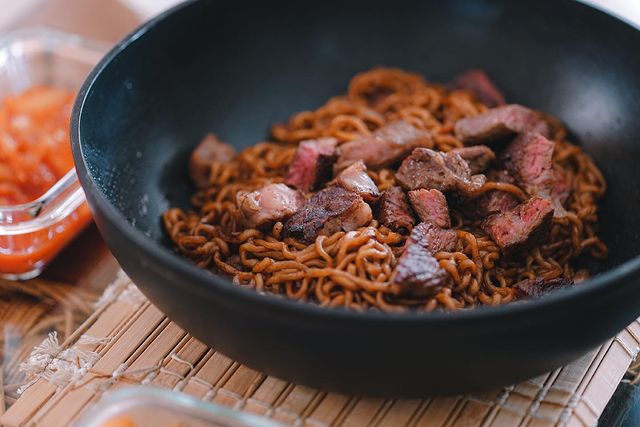
Image credit: @rperture
Jjapaguri is a mix of two types of jjapaghetti and neoguri, hence the name “jjapaguri”.
Jjapaghetti is an instant noodle dish with black bean paste, while neoguri is an instant noodle dish with thick noodles and spicy seasoning.
Jjapaguri is also known as ram-don. This unique ramyun dish was featured in the popular Korean movie Parasite, where the rich were seen zhuzhing up the “peasant” dish by adding premium hanwoo beef.
Ingredients:
- 1 packet of jjapaghetti
- 1 packet of neoguri
- 8 oz of rib-eye or sirloin steak (optional)
- 1 tsp of vegetable oil
- 1 tbsp of unsalted butter
- Salt
- Black pepper
Steps:
Steak
- If you feel like eating the upgraded version of jjapaguri, you can choose to add steak. Chop the steak into approximately ½ inch cubes.
- Add the steak cubes, a pinch of salt and pepper, and vegetable oil in a pan. Mix well.
- Stir-fry the steak cubes over high heat for approximately 2 to 3 minutes, until they turn light brown.
- Add 1 tbsp of unsalted butter and stir until the butter melts completely. Remove from the heat.
Noodles
- Fill half a pot with water and bring to a boil.
- Add the jjapaghetti and neoguri noodles to the pot.
- Add the vegetable flakes that come with the noodles.
- Stir the noodles occasionally. After 2 to 3 minutes, remove the pot from the heat.
- Strain the noodles over a medium-sized bowl, then place the drained noodles back into the pot.
- Pour 240g of the strained soup back into the pot with the noodles.
- Place the pot on low heat. Add all of the black sauce powder that comes with the jjapaghetti, and half of the spicy seasoning that comes with the neoguri. Mix well.
- Add the cooked steak cubes and mix well.
- Remove the pot from the heat.
- Add the seasoning oil that comes with the jjapaghetti. Mix well.
Check out the original recipe:
Video credit: Maangchi
3. Yukkal
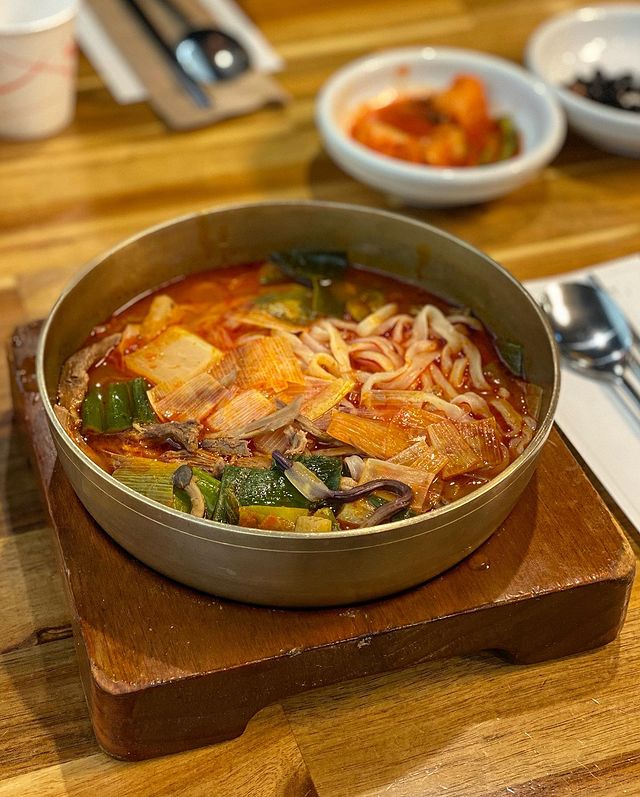
Image credit: @yamm2ee
When you combine yukgaejang and kalguksu, you get yukkal, a Korean spicy beef ramyun.
Yukgaejang is a popular spicy beef soup in Korea, while kalguksu is a Korean knife-cut noodle dish. The noodles are flat and rectangular, and are usually served in a clear broth.
Yukkal is a hearty dish that’s easy to make. We recommend eating this on cold days.
Ingredients:
- 3 dried shiitake mushrooms
- 1 tbsp of sesame oil
- 4 green onions
- 1 tbsp of gochugaru (Korean red pepper flakes)
- 4 oz of thinly sliced beef
- 1 packet of spicy beef-flavoured ramyun
- 1 tbsp of light soy sauce
- 1 clove of garlic
- 1 egg
- Beansprouts
Steps:
- Soak the three shiitake mushrooms in ½ cup of water while you prepare the other ingredients.
- Cut the green onions into approximately 2-inch long pieces.
- Place a pot on low heat and pour in 1 tbsp of sesame oil.
- Add the green onions and 1 tbsp of gochugaru into the pot as well.
- Remove the mushrooms from the water and pour the water into the pot.
- Slice up the mushrooms and add them in the pot.
- Add the seasoning from the ramyun packet and a tbsp of light soy sauce into the pot.
- Bring the soup to a boil. While waiting, mince the garlic and crack an egg into a small bowl.
- Once the soup boils, add the ramyun. After approximately 1 minute, add the minced garlic, egg, and a handful of bean sprouts into the pot. Cover the pot with a lid and let it boil for a minute before removing from the heat.
Check out the tutorial for yukkal below:
Video credit: Seonkyoung Longest
4. Haemul ramyun
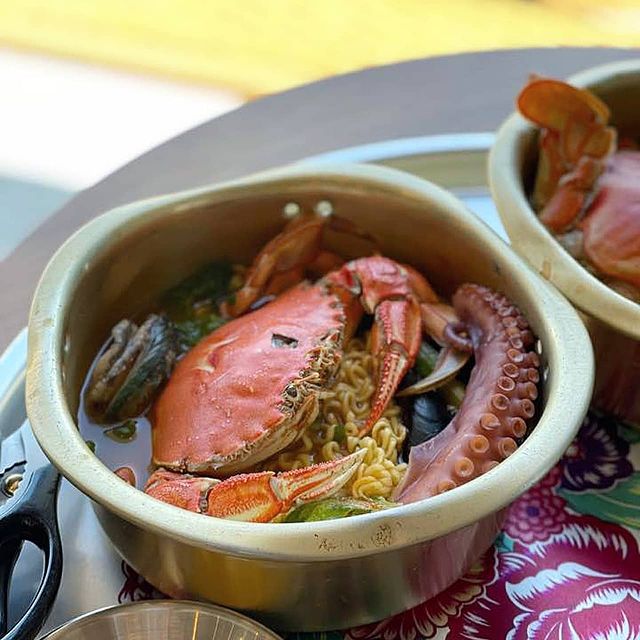
Image credit: @yenie.kendal
Haemul means “seafood”, so haemul ramyun simply means “seafood ramyun”.
The noodles are pretty easy to make. The tough part about this dish is preparing the seafood. Some people may not be experienced or comfortable with preparing seafood, but you can simply omit seafood that is hard to cook, such as crabs.
Adding seafood to your basic ramyun will jazz up the taste profile of your dish. In this recipe, shrimp, clams, calamari, squid, and mussels are added to the noodles.
Ingredients:
- 1 tbsp of cooking oil
- 2 cloves of garlic
- 2 green onions
- 2 packets of Korean ramyun
- 1 lb of mixed seafood
- 2 eggs (optional)
Steps:
- Mince 2 cloves of garlic.
- Chop the green onions into small pieces.
- Place a pot on medium heat and pour in a tbsp of cooking oil.
- Add the minced garlic and chopped green onions into the pot as well.
- Fry the garlic and green onions for approximately 1 to 2 minutes.
- Fill half the pot with water.
- Add the seasoning that comes with the ramyun packet. Stir the mixture.
- Once the soup boils, add the ramyun noodles.
- Once the ramyun noodles are a little soft, add the seafood. The seafood used in this recipe are shrimp, clams, mussels, squid, and calamari. You can swap it out as you like.
- Let the noodles boil until the seafood is cooked. Add eggs if you like.
- Remove the pot from the heat.
Check out the tutorial below:
Video credit: Seonkyoung Longest
5. Sundubu ramyun
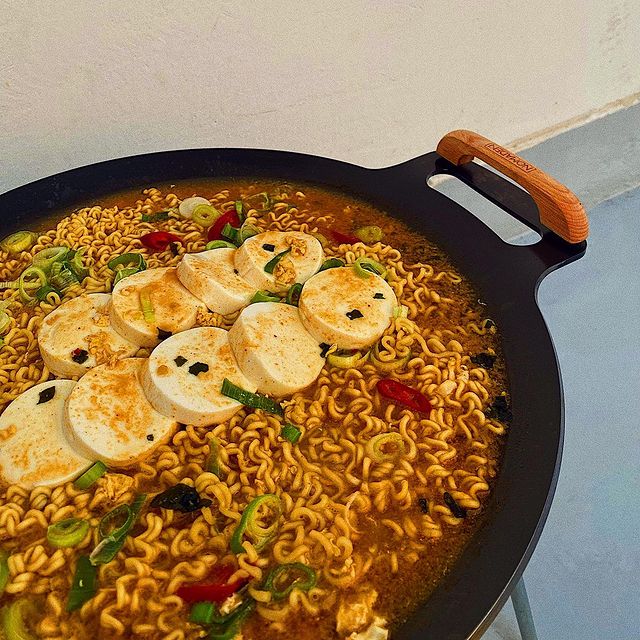
Image credit: @b.bi.a
Sundubu ramyun is just ramyun with tofu and it’s super easy to make. Sundubu ramyun is a dish inspired by sundubu-jjigae, and it went viral in Korea in 2020. It’s extremely popular among Korean students who wish to have a simple meal while studying.
Koreans usually use Ottogi’s Yeul Ramyun for sundubu ramyun, but you can use other brands, such as Shin Ramyun, which is much easier to find if you’re living outside of Korea.
Silken tofu is usually used for this dish, but you can also use regular tofu. Silken tofu, just as its name suggests, is softer and smoother compared to regular tofu.
Ingredients:
- ½ packet of ramyun
- 180g of silken tofu
- ½ tbsp of minced garlic
- 1 egg
- Black pepper
- Chopped spring onions (optional)
Steps:
- In a pot, add some water and 180g of silken tofu. The amount of water that you should add depends on the size of the pot you’re using. The water should be just enough to cover the tofu.
- Add all of the dry seasoning that comes with the ramyun packet, and half of the spicy seasoning.
- Then, add the noodles, ½ tbsp of minced garlic, an egg, some black pepper, and chopped spring onions.
- Let the noodles boil for 1 to 2 minutes, then remove the pot from the heat.
Check out the tutorial below:
Video credit: Future Neighbor
6. Kimbura
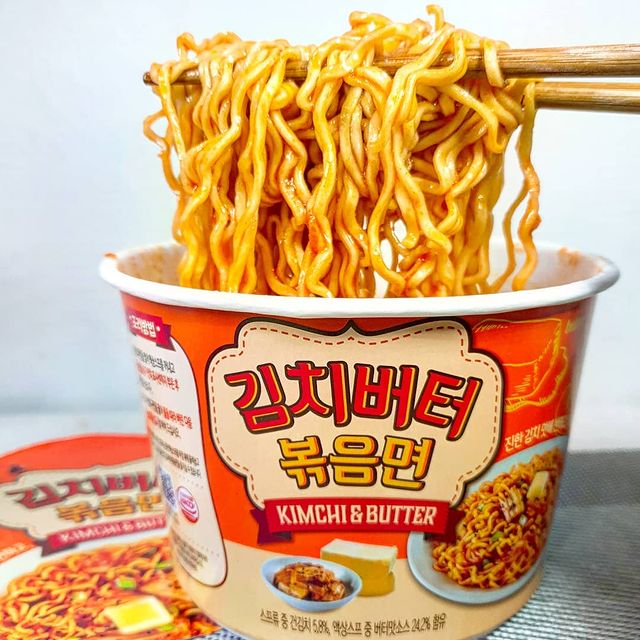
Image credit: @zikmukzikzzik
Kimbura, which is short for “kimchi butter ramyun”, is simply kimchi ramyun mixed with butter.
This dish is perfect for those who have a low spice tolerance. The butter in the ramyun helps to make the noodles less spicy.
You can buy instant kimbura, but it’s not easy to find outside of Korea. Luckily, it’s easy to make at home.
Ingredients:
- 1 packet of ramyun
- ½ cup of kimchi
- 1 tbsp of butter
- ¼ cup of chopped onions
- 2 cups of water
Steps:
- Place a pot over medium heat and add the kimchi, chopped onions and butter. Mix well.
- Add 2 cups of water to the same pot. If you’re unsure of how much water to add, check the ramyun package for instructions.
- Bring the mixture to a boil, then add the ramyun and the seasoning that comes with the ramyun packet.
- Remove the pot from the heat.
Check out the original recipe.
7. Golbim-myun
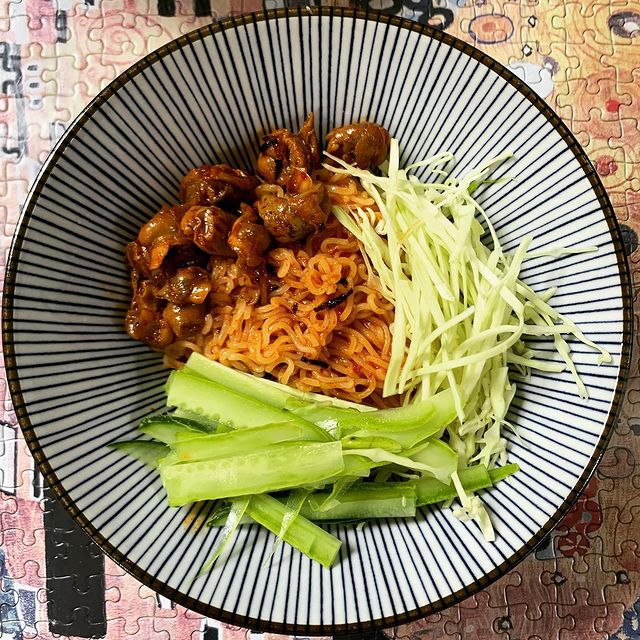
Image credit: @cciwoo11
Golbim-myun is whelk ramyun. Whelks are sea snails, and they’re enjoyed in Korea as a side dish called golbaengi-muchim.
Like all the other recipes on this list, golbim-myun is extremely easy to make. All you need to do is add whelk to your basic ramyun.
If you don’t like eating raw seafood, you can substitute it with cooked squid or calamari.
Ingredients:
- 1 packet of bibim ramyun
- 2 green onions
- Cucumber
- A can of whelk
- Sesame seeds
- Sesame oil
Steps:
- Cook the ramyun noodles following the instructions on the package. Do not add the bibim sauce that comes with the ramyun packet.
- Once done, rinse the noodles in cold water and drain them. Place the dry noodles in a bowl and set it aside.
- Chop the green onions into small pieces and soak the pieces in some cold water for about 2 to 3 minutes.
- Slice the cucumber, then cut each piece into half.
- Slice the whelk into small pieces.
- In a bowl, mix the cucumber, whelk, and chopped green onions with the bibim sauce.
- Place the mixture on top of the ramyun that you set aside earlier, and sprinkle some sesame seeds on top as the finishing touch. You can also drizzle some sesame oil on top.
Check out the original recipe.
8. Milk ramyun
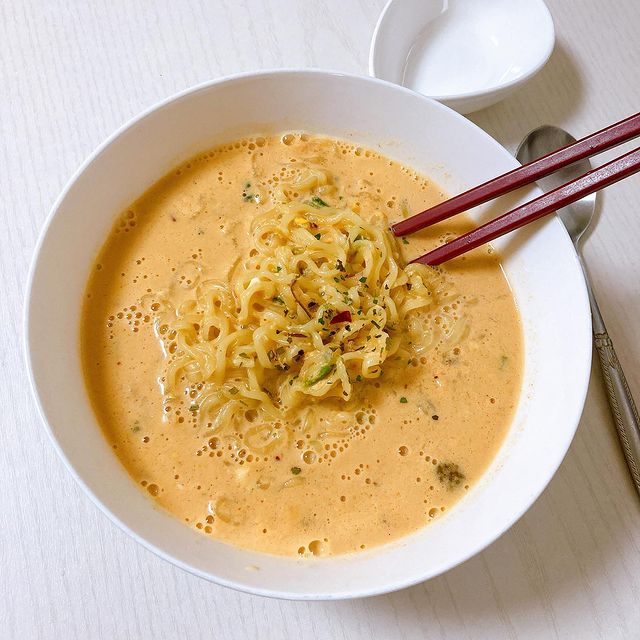
Image credit: @ela_foodie
If you have a low spice tolerance, consider adding milk to your ramyun.
Instant milk ramyun is available in convenience stores and supermarkets in Korea, but hard to find outside of the country. Not to worry though – it’s easy to make milk ramyun.
Adding milk to ramyun gives it a carbonara-like taste and texture. If you’re a fan of carbonara, do give this recipe a try.
To jazz up this simple dish, you can add whatever that’s left over in your fridge. Vegetables, sausages, and mushrooms are some ingredients that you can add to your milk ramyun.
Ingredients:
- 1 packet of ramyun
- 350ml of milk
- Anything else you can find in your fridge – this recipe uses broccoli, sausages, and mushrooms
Steps:
- Chop the broccoli, sausages, and mushrooms into smaller pieces.
- Fill a pot with water and add the ramyun when the water boils. Do not add the spicy seasoning yet.
- Cook the ramyun for approximately 2 minutes, then drain the ramyun and rinse with cold water. The ramyun should not be completely cooked at this stage because it will continue to cook in the milk later.
- Add the broccoli, mushrooms, and sausages in a pan. Stir-fry till everything is cooked.
- Add 350ml of milk, spicy seasoning, and the ramyun into the pan.
- Let the noodles simmer in the pan. Be careful not to let the milk burn.
- At this point, you can choose to add some gochugaru for a darker and spicier broth.
- When the broth starts to bubble rapidly, quickly remove the pan from the heat.
Check out the tutorial below:
Video credit: Future Neighbor
Easy ramyun recipes for a scrumptious meal
These 8 easy ramyun recipes will delight your taste buds, so do give them a try. Not only are they delicious and nutritious, but they’re also simple to make with readily available ingredients.
Also check out:
- 8 easy Korean diet recipes that don’t taste like plain tofu
- 9 Korean bread recipes you can make for breakfast
- 10 Korean sweet potato recipes besides steamed goguma
- 8 easy Korean recipes to cook at home
- 8 Korean convenience store food recipes you can try at home
Cover image adapted from: @ela_foodie and @yenie.kendal
